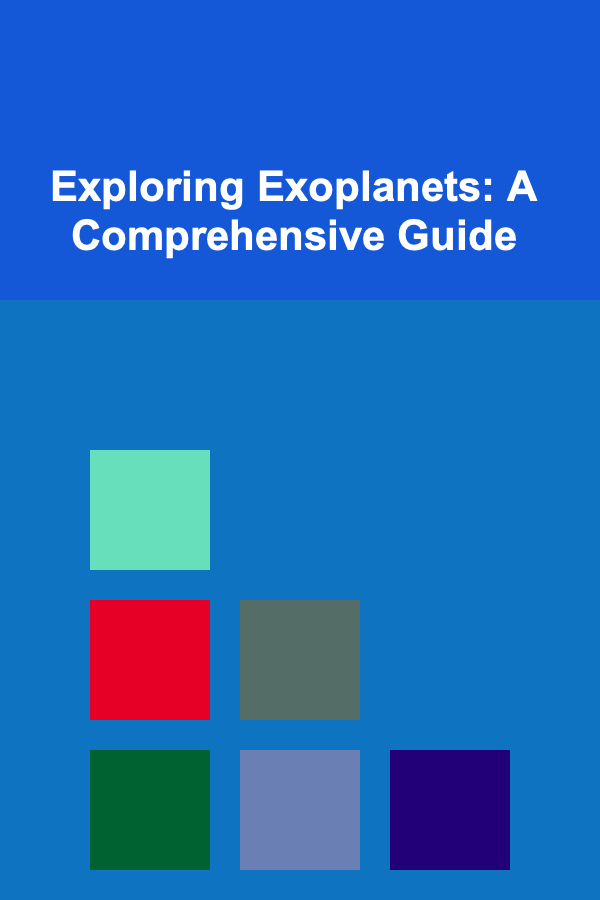
Exploring Exoplanets: A Comprehensive Guide
ebook include PDF & Audio bundle (Micro Guide)
$12.99$6.99
Limited Time Offer! Order within the next:

The quest to understand our place in the universe has driven humanity for centuries. A central part of that quest is the search for and characterization of exoplanets -- planets orbiting stars other than our Sun. The discovery of the first confirmed exoplanet in the early 1990s, 51 Pegasi b, revolutionized our understanding of planetary systems and sparked an explosion of research. Today, thousands of exoplanets have been identified, revealing a stunning diversity of planetary types and system architectures that far exceed what we observe in our own solar system. This article delves into the multifaceted world of exoplanet exploration, covering the methods used to find and study these distant worlds, the challenges involved, and the exciting prospects for future discoveries.
I. The Motivation for Exoplanet Exploration
The drive to explore exoplanets stems from several fundamental questions:
- Are we alone? Finding another planet capable of supporting life is arguably the most profound question humanity can ask. Exoplanet exploration is a crucial step in addressing this question.
- How unique is our solar system? By studying exoplanetary systems, we can compare them to our own and gain a better understanding of the processes that led to the formation and evolution of our solar system.
- What are the conditions necessary for life to arise? Identifying habitable planets and characterizing their atmospheres can provide clues about the environmental factors that make a planet conducive to life.
- Can we predict the future of Earth? Studying exoplanets, particularly those undergoing different stages of stellar evolution, can provide insights into the long-term fate of our own planet.
These questions, combined with the inherent human curiosity to explore the unknown, fuel the ongoing efforts to discover and characterize exoplanets.
II. Methods of Exoplanet Detection
Detecting exoplanets is an incredibly challenging task. Exoplanets are incredibly faint and are located vast distances away, dwarfed by the light of their host stars. Therefore, astronomers rely on indirect methods to detect and characterize these distant worlds. Several techniques have been developed, each with its own strengths and limitations:
A. Radial Velocity (Doppler Spectroscopy)
The radial velocity method, also known as Doppler spectroscopy, exploits the fact that a star and a planet orbit their common center of mass. As a planet orbits a star, the star wobbles slightly due to the planet's gravitational pull. This wobble causes the star's light to be alternately blue-shifted (as the star moves towards us) and red-shifted (as the star moves away from us). By measuring these minute changes in the star's radial velocity, astronomers can infer the presence of a planet.
Advantages:
- Can determine the planet's minimum mass and orbital period.
- Relatively long history and well-established techniques.
Disadvantages:
- Sensitive to massive planets close to their stars (hot Jupiters).
- Cannot determine the planet's radius or inclination.
- Requires high-precision spectroscopic observations over long periods.
B. Transit Photometry
The transit photometry method detects planets by observing the slight dimming of a star's light as a planet passes in front of it. This event, called a transit, blocks a small fraction of the star's light, causing a dip in its brightness. By measuring the depth and duration of these dips, astronomers can determine the planet's radius and orbital period.
Advantages:
- Can determine the planet's radius.
- Efficient for surveying large numbers of stars (used extensively by Kepler and TESS).
- Can be used to study planetary atmospheres during transit (transmission spectroscopy).
Disadvantages:
- Requires the planet's orbit to be aligned edge-on with our line of sight.
- Can be prone to false positives (e.g., from eclipsing binary stars).
- Difficult to detect small planets orbiting large stars.
C. Direct Imaging
Direct imaging involves taking pictures of exoplanets directly. This is incredibly challenging because exoplanets are so faint compared to their host stars. To overcome this challenge, astronomers use coronagraphs or starshades to block out the starlight, allowing the faint light from the planet to be detected.
Advantages:
- Can directly measure the planet's light and spectrum.
- Can be used to study planetary atmospheres and search for biosignatures.
- Provides information about the planet's composition and temperature.
Disadvantages:
- Extremely challenging and requires advanced instrumentation.
- Favors large, young, and hot planets far from their stars.
- Limited number of exoplanets have been directly imaged.
D. Gravitational Microlensing
Gravitational microlensing utilizes the bending of light by massive objects, as predicted by Einstein's theory of general relativity. When a star passes in front of a more distant star, the gravity of the foreground star acts as a lens, magnifying the light from the background star. If the foreground star has a planet, the planet's gravity can cause an additional brief spike in the magnification, revealing its presence.
Advantages:
- Sensitive to planets at large distances from their stars.
- Can detect planets of various sizes, including Earth-sized planets.
- Can probe planets that are too faint to be detected by other methods.
Disadvantages:
- Rare and unpredictable events.
- Difficult to follow up observations.
- Provides limited information about the planet beyond its mass and distance from the star.
E. Astrometry
Astrometry measures the precise position of a star over time. Like the radial velocity method, astrometry detects the wobble of a star caused by the gravitational pull of its planets. However, instead of measuring the star's velocity, astrometry measures its actual position in the sky. This method is particularly sensitive to planets with long orbital periods.
Advantages:
- Sensitive to planets with long orbital periods.
- Can determine the planet's true mass and orbital inclination.
Disadvantages:
- Requires extremely precise measurements of stellar positions over long periods.
- Technologically challenging.
- Limited number of exoplanets have been detected using this method.
F. Transit Timing Variations (TTVs) and Transit Duration Variations (TDVs)
These methods are used to detect additional planets in systems already known to have one or more transiting planets. TTVs occur when the timing of a planet's transit deviates from the expected regular intervals due to the gravitational influence of another planet in the system. TDVs occur when the duration of a transit changes due to the same influence. These variations provide information about the masses and orbits of the interacting planets.
Advantages:
- Can detect non-transiting planets in multi-planet systems.
- Provides information about planetary interactions and system architecture.
Disadvantages:
- Requires very precise transit timing measurements.
- Can be complex to interpret.
III. Exoplanet Characterization
Once an exoplanet is detected, the next step is to characterize its properties. This involves determining the planet's size, mass, density, temperature, and atmospheric composition. Characterization is crucial for understanding the planet's potential habitability and its place in the broader context of planetary systems.
A. Determining Size and Mass
The size of an exoplanet can be determined from transit photometry. The amount of light blocked during a transit is proportional to the ratio of the planet's area to the star's area. The mass of an exoplanet can be determined from radial velocity measurements or from transit timing variations. Combining the size and mass allows astronomers to calculate the planet's density, which provides clues about its composition (e.g., rocky, gaseous, or icy).
B. Measuring Temperature
The temperature of an exoplanet can be estimated based on its distance from its star and the star's luminosity. However, this is a crude estimate, as the planet's atmosphere can significantly affect its temperature. Direct imaging can also be used to measure the planet's infrared emission, providing a more accurate estimate of its temperature.
C. Studying Atmospheres
Studying exoplanet atmospheres is crucial for understanding their composition, temperature structure, and potential habitability. Several techniques are used to study exoplanet atmospheres:
1. Transmission Spectroscopy
This technique involves observing the spectrum of starlight that passes through the planet's atmosphere during a transit. Certain wavelengths of light are absorbed by specific molecules in the atmosphere, creating absorption lines in the spectrum. By analyzing these absorption lines, astronomers can identify the molecules present in the atmosphere, such as water vapor, methane, carbon dioxide, and oxygen.
2. Emission Spectroscopy
This technique involves measuring the planet's thermal emission at different wavelengths. The shape of the emission spectrum provides information about the temperature structure and composition of the atmosphere.
3. Phase Curve Analysis
As a planet orbits its star, the amount of light reflected from its surface and atmosphere changes. By measuring these changes in brightness (the phase curve), astronomers can map the planet's surface temperature and cloud distribution.
D. Searching for Biosignatures
A major goal of exoplanet characterization is to search for biosignatures -- indicators of life. These could include:
- Oxygen: A significant amount of oxygen in a planet's atmosphere could be an indication of photosynthesis. However, oxygen can also be produced abiotically (without life), so it is not a definitive biosignature.
- Methane: Methane is a relatively short-lived gas that is often produced by biological processes.
- Water Vapor: The presence of water vapor in a planet's atmosphere is essential for life as we know it.
- Ozone: Ozone is produced when oxygen is exposed to ultraviolet radiation. Its presence suggests a source of oxygen.
- Disequilibrium Chemistry: The presence of gases in the atmosphere that should not coexist in equilibrium (e.g., methane and oxygen) could indicate biological activity.
The search for biosignatures is a complex and challenging undertaking. It requires careful analysis of exoplanet atmospheres and a thorough understanding of the potential for false positives.
IV. Current and Future Missions
The field of exoplanet exploration is rapidly advancing, driven by the development of new and more powerful telescopes and instruments. Several current and future missions are playing a key role in this effort:
A. Current Missions
1. Kepler Space Telescope
Kepler was a NASA mission that surveyed a patch of sky in the Cygnus constellation, monitoring the brightness of over 150,000 stars. It discovered thousands of exoplanets, mostly using the transit photometry method. Kepler revolutionized our understanding of exoplanet demographics, revealing that planets are common around stars.
2. Transiting Exoplanet Survey Satellite (TESS)
TESS is a NASA mission that is surveying the entire sky, searching for exoplanets orbiting nearby bright stars. TESS uses the transit photometry method and is designed to find planets that are suitable for follow-up characterization by other telescopes.
3. James Webb Space Telescope (JWST)
JWST is a NASA, ESA, and CSA mission that is the most powerful space telescope ever built. JWST is capable of studying the atmospheres of exoplanets in unprecedented detail. It uses transmission spectroscopy and emission spectroscopy to identify the molecules present in exoplanet atmospheres and to measure their temperatures. JWST is expected to play a major role in the search for biosignatures on exoplanets.
B. Future Missions
1. Nancy Grace Roman Space Telescope
The Roman Space Telescope (formerly WFIRST) is a NASA mission that will use gravitational microlensing to search for exoplanets and will also conduct a coronagraphic survey to directly image exoplanets. It is designed to find planets at a wide range of distances from their stars, including Earth-sized planets in the habitable zone.
2. Extremely Large Telescope (ELT)
The ELT is a ground-based telescope being built by the European Southern Observatory (ESO). It will have a primary mirror diameter of 39 meters, making it the largest optical telescope in the world. The ELT will be used to directly image exoplanets and to study their atmospheres with high spectral resolution.
3. Atmospheric Remote-sensing Infrared Exoplanet Large-survey (ARIEL)
ARIEL is a European Space Agency (ESA) mission dedicated to observing a large and diverse sample of exoplanets to determine their atmospheric composition. By observing hundreds of warm to hot exoplanets in the infrared, ARIEL will provide invaluable data for understanding the relationship between a planet's atmosphere and its environment.
4. LIFE (Large Interferometer For Exoplanets)
LIFE is a proposed European Space Agency mission that aims to directly detect thermal radiation emitted by Earth-like exoplanets and to characterize their atmospheric composition. The mission relies on a space-based mid-infrared nulling interferometer to suppress the light from the host star and to enable direct detection and characterization of planets in the habitable zone.
V. Challenges and Future Directions
Exoplanet exploration is a field that faces many challenges. The sheer distances involved, the faintness of exoplanets, and the complexities of interpreting data require innovative technologies and sophisticated analysis techniques. Some of the key challenges and future directions include:
A. Overcoming Observational Challenges
- Improving Contrast: Blocking out the starlight to directly image exoplanets requires extremely high contrast. Developing advanced coronagraphs and starshades is crucial.
- Increasing Sensitivity: Detecting small, Earth-sized planets requires highly sensitive telescopes and detectors.
- Reducing Noise: Minimizing the effects of atmospheric turbulence, instrumental noise, and other sources of error is essential for obtaining accurate measurements.
B. Refining Data Analysis Techniques
- Developing Robust Algorithms: Analyzing transit data, radial velocity data, and direct imaging data requires sophisticated algorithms to distinguish true planet signals from noise and false positives.
- Modeling Planetary Atmospheres: Interpreting exoplanet spectra requires accurate models of planetary atmospheres, taking into account factors such as cloud formation, chemical reactions, and atmospheric dynamics.
- Addressing False Positives: Developing methods to distinguish genuine exoplanet signals from false positives, such as eclipsing binary stars or stellar activity, is crucial.
C. Expanding the Search for Habitable Planets
- Defining Habitability: Refining our understanding of the conditions necessary for life to arise is essential for targeting the most promising exoplanets for detailed characterization.
- Searching for Biosignatures: Developing more sensitive and reliable methods for detecting biosignatures is a major goal of exoplanet exploration.
- Understanding Planetary Formation: Gaining a better understanding of how planets form and evolve is crucial for predicting which planets are most likely to be habitable.
D. The Search for Exomoons
While the search for exoplanets has been tremendously successful, the next frontier may well be the search for exomoons -- moons orbiting exoplanets. The detection of exomoons would provide valuable insights into the formation and evolution of planetary systems and could even reveal new habitable environments. However, detecting exomoons is extremely challenging due to their small size and faintness. Researchers are exploring various techniques to detect exomoons, including transit timing variations, transit duration variations, and gravitational microlensing.
VI. Conclusion
The exploration of exoplanets is a rapidly evolving field with the potential to revolutionize our understanding of the universe and our place within it. The discovery of thousands of exoplanets has revealed a remarkable diversity of planetary systems and has raised profound questions about the possibility of life beyond Earth. With ongoing and future missions, coupled with advancements in observational techniques and data analysis, we are poised to make even more groundbreaking discoveries in the years to come. The search for exoplanets is not just a scientific endeavor; it is a testament to human curiosity and our unwavering quest to unravel the mysteries of the cosmos. It is a journey that holds the promise of answering some of the most fundamental questions about our existence and our place in the vast expanse of the universe.

How To Discover the Epic of Gilgamesh
Read More
How to Find Your Inner Wisdom
Read More
How to Set Up a Seasonal Wardrobe Rotation
Read More
How To Master Eclectic Interior Design
Read More
Incorporating Active Recovery for Enhanced Performance and Well-being
Read More
How to Incorporate More Protein into Your Meals
Read MoreOther Products

How To Discover the Epic of Gilgamesh
Read More
How to Find Your Inner Wisdom
Read More
How to Set Up a Seasonal Wardrobe Rotation
Read More
How To Master Eclectic Interior Design
Read More
Incorporating Active Recovery for Enhanced Performance and Well-being
Read More